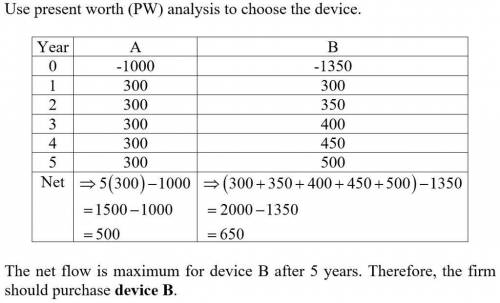
Business, 10.12.2019 04:31 amberskids2
Afirm is trying to decide which of two devices to install to reduce costs in a particular situation devices a costs $1000, device b costs $1350 and both have useful lives of 5 years and no salvage value device a can be expected to result in $300 savings annually device b will provide cost savings of $300 the first year, but savings will increase by $50 annually, making the second-year savings $350, the third-year savings $400, and so forth with interest rate at 7%, which device should the firm purchase? use cost benefit ratio to solve this question. show all your steps, build models, provide them with number, come up with results and show their units, then, draw conclusions.

Answers: 2


Another question on Business

Business, 22.06.2019 17:50
What additional information about the numbers used to compute this ratio might be useful in you assess liquidity? (select all that apply) (a) the maturity schedule of current liabilities (b) the average stock price for the industry (c) the average current ratio for the industry (d) the amount of current assets that is concentrated in relatively illiquid inventories
Answers: 3


Business, 23.06.2019 00:50
Mr. drucker uses a periodic review system to manage the inventory in his dry goods store. he likes to maintain 15 sacks of sugar on his shelves based on the annual demand figure of 225 sacks. it costs $2 to place an order for sugar and costs $1 to hold a sack in inventory for a year. mr. drucker checks inventory one day and notes that he is down to 9 sacks; how much should he order?
Answers: 1

Business, 23.06.2019 17:30
4. understanding different policy options to correct for negative externalities carbon dioxide emissions have been linked to global warming. the following table lists some possible public policies aimed at reducing the amount of carbon dioxide in the air. for each policy listed, identify whether it is a command-and-control policy (regulation), tradable permit system, corrective subsidy, or corrective tax. public policy command-and-control policy tradable permit system corrective subsidy corrective tax the government charges factories $110 for every ton of carbon dioxide they emit. the government orders every factory to adopt a new technology, which reduces carbon-dioxide emissions into the atmosphere. trees take carbon dioxide out of the air and convert it to oxygen, so the government funds a tree-planting initiative by offering $110 to any citizen who plants a tree. the government limits total carbon-dioxide emissions by all factories to 180,000 tons per month. each individual factory is given the right to emit 140 tons of carbon dioxide, and factories may buy and sell these rights in a marketplace.
Answers: 2
You know the right answer?
Afirm is trying to decide which of two devices to install to reduce costs in a particular situation...
Questions

Chemistry, 02.07.2019 06:30

Mathematics, 02.07.2019 06:30

History, 02.07.2019 06:30


Social Studies, 02.07.2019 06:30

Mathematics, 02.07.2019 06:30

Social Studies, 02.07.2019 06:30

Biology, 02.07.2019 06:30


History, 02.07.2019 06:30


Biology, 02.07.2019 06:30

Biology, 02.07.2019 06:30

Social Studies, 02.07.2019 06:30

English, 02.07.2019 06:30

Business, 02.07.2019 06:30




Chemistry, 02.07.2019 06:30




